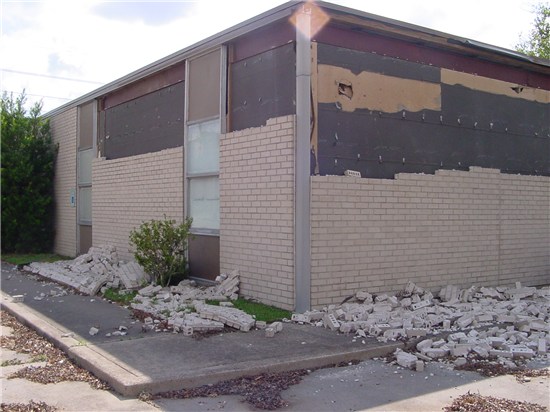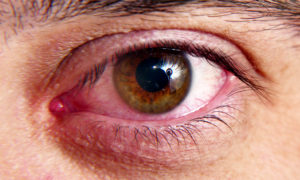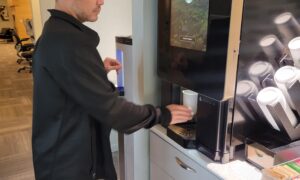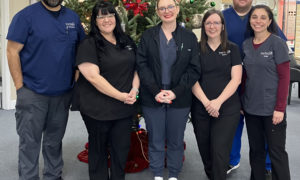By Peter J. Cass, OD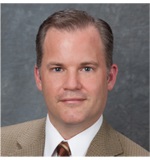
SYNOPSIS
Prepare for natural disasters–and respond efficiently—to minimize damage to the practice while remaining HIPAA compliant.
ACTION POINTS
MAKE USE OF ADVANCE WARNING. Get all records and electronics above two-foot level, turning off everything in the office, and unplugging everything in the office.
ASSESS DAMAGE. Calculate likely cost and contact insurance company.
LEVERAGE RELATIONSHIP WITH VENDORS. See if willing towaive late fees and delay billing for 30 days.
Within three years,my Beaumont, Texas, practice was impacted by two hurricanes–Hurricane Rita in 2005 and Hurricane Ike in 2008. Both of these storms damaged our office and interrupted our operations, but thanks to adequate planning and an effective response, we recovered in short time, and our practice is even better than before.
A willingness to work hard, deal with inconvenience and find creative solutions to open quickly and restore operations was key to our survival after the storm.
Damage to Dr. Cass’s office from one of the two hurricanes to hit his practice within three years. Dr. Cass recommends contacting the insurance company as soon as possible, and re-opening to see patients–even if the office repairs are not yet complete.
Make Use of Advance Warning
The path of a hurricane is unpredictable, often changes at the last minute, and the strength is also hard to predict. We had about a week’s notice that these hurricanes were likely headed toward us, and only about two days’ notice that the hurricanes were definitely headed toward us.
We made relatively simple preparations for each hurricane.
Having lived in the area for over 30 years, I have noted that extensive preparations don’t protect from rising water or falling trees, and don’t offer much protection from very strong hurricanes. Basic preparation is a must, though, and our preparations included gathering important documents, getting all records and electronics above the two-foot level, turning off everything in the office and unplugging everything in the office.
These preparations definitely helped as none of our records were lost or damaged, and nearly all of our electronics and equipment survived.
When the first projections showed our city in the potential path of a hurricane, my staff and I discussed the likelihood of being in the direct path of the storm, closely watched storm predictions, and discussed when we might close the office and how we would stay connected in the event of a mandatory evacuation.
As it became more obvious that we were in the direct path of the hurricane, we had daily meetings with the staff each morning. When the mandatory evacuation order was given by the city, we communicated with every staff member by phone and put our plans in place.
Disaster Preparation: Step-by-Step
Before a Crisis
• Meet regularly with staff if you have any warning
• Confirm that your staff and families have somewhere to go and that they will be safe
• Be sure to get contact information for all staff members
• Establish a protocol for communication
• Check your insurance policy coverage and make sure that you understand it
• Get contact information for lenders and vendors
• Secure records and any Private Health Information
• Back up electronic data
• Secure and cover equipment
• Unplug and move computers and electronics
• Take photos prior to storm to show undamaged state of office.
After a Crisis
• Check on staff to make sure they are safe and have basic needs taken care of
• Assess office damage as quickly as possible
• Photo-document everything; compare to before photo.
• Make notes of damage
• Secure property and protect from the elements as best as possible
• Contact insurance company
• Remove debris and damaged equipment if safe to do so (check with your insurance company to see if you can begin the cleanup process before an adjustor arrives)
• Clean up as best as possible
• Contact vendors and ask for payment deferrals and relief from late fees and penalties
• Contact lenders and ask about deferrals or moving payments to the end of the loan term
• If the office is at all usable, open as soon as possible (take into account your insurance policy’s terms and restrictions on loss-of-business income and weigh the benefits of opening sooner versus later)
• Be prepared to deal with inconvenience, and focus on customer service. Patients are generally sympathetic and appreciate the effort.
Assess the Property and Office Damage
In Hurricane Rita, the north wall of our office building was partially ripped off by high winds. There was heavy damage to our work-up room, one of our two exam lanes, a private office and our contact lens room. With Hurricane Ike, similar damage occurred when the south wall was ripped off the building. In addition to the physical damage to our property, we were unable to reopen the practice because the city was closed for 14 days. During this time, law enforcement would not allow anyone but utility and emergency service workers to come into the city.
Once we were allowed to come back in and survey damage, there was still limited power, many businesses did not get power restored for 24 days and phone service took almost 30 days. Ultimately it was nearly a month before we were able to see patients, which meant a full month with no income to our practice at all.
When we were allowed in town to survey property damage we placed a tarp over the damaged roof and walls. About two weeks later, we we were allowed back in town on a more regular basis and were able to move undamaged equipment, remove all the damaged and wet materials (including walls), chemically treat all the wet areas and seal off the damaged areas. We took pictures of and documented everything. You should check with your insurance company before doing any repairs, but most insurance companies will expect you to do whatever you can to mitigate further damage.
Calculate How Much Cost to Practice
We got bids from licensed contractors, with Hurricane Rita resulting in property damage of around $48,000, and Hurricane Ike resulting in property damage of around $39,500. We also used profit and loss statements and historical sales data to calculate loss of gross income of around $85,000 for Rita and around $51,000 for Ike. In total, the property damage and loss of income approached a quarter of a million dollars.
Stay in Touch with Staff
I strongly believe that great staff are the foundation of quality patient care and exceptional customer service, so the practice owner should look out for the well-being of the staff during natural (or man-made) disasters. I stayed in constant contact with my staff during the crisis and provided all of them with their normal pay during the entire four weeks that the office was closed. At the time I did not realize that I would be reimbursed for those expenses by our insurance, but knew the staff needed the money, so I found a way to pay them.
Leverage Relationships with Vendors
Soon after the hurricane, when we realized we were going to be without power for weeks, but not without bills, we began contacting vendors. To our relief, nearly every vendor that we spoke with delayed billing for 30 days, waived late fees, and many even offered to spread out payments after that point. Most of our lenders agreed to skip payments on real estate and equipment and just add those payments to the end of the loan. We were pleasantly surprised by the response.
Two vendors in particular stood out, the first was Vision Source. They called to check on us and sent us a check within days of the hurricane to help provide living expenses for my staff and myself. Additionally, Essilor, which represented our largest single bill each month, agreed to postpone payments, and waive late fees until we were able to pay.
Get Up and Running Again
After nearly four weeks, the phones were restored, and because we had made temporary repairs to the building, we were able to see patients in our own office. We did this in a heavily damaged building, which had plastic sealing off many of the rooms, and equipment and supplies crammed into the few undamaged rooms in the office. This may not be an option for everyone, and you need to check with your insurance company to make sure that you will not disqualify yourself from a loss of business claim, but for our office it was the best decision.
At first I was embarrassed by the state of our office, but I came to realize quickly that patients were not bothered by the mess at all. In fact, patients were very happy to have access to eyecare because many of the other practices in town were closed due to hurricane damage. Similarly, I was happy that our neighborhood grocery store was open even though it was missing all the front windows, and even happier when our favorite restaurant opened again even though they had one wall that was simply a big blue tarp.
Most other business owners also were working with what they had, and were just trying to get back to normal. People were appreciative of any business that was willing to do so. In our practice, we even continued to work during the rebuilding and repair process. It was challenging, but necessary to provide eyecare to those who had few other options, and it helped restore cash flow for our practice.
Patients Appreciate Re-Opened Doors
I distinctly remember being in the office by myself on the day the phones were restored. I was checking on things when a line repairman popped his head in the door and told me the phones should be on. He asked me to check for a dial tone. I confirmed a dial tone, hung up the phone and thanked him for his service. Immediately the phone rang, and I thought it must be some sort of error, but answered anyway. A patient on the other end exclaimed: “Thank God you’re open! I just got back in town and I am out of contacts. Can I come by and pick some up?”
I was happy to help and surprised by the call, but as soon as I hung up the phone, it rang again. Within a couple hours I had filled up an entire day’s schedule for the following Monday. Our office was a mess, but simply opening the doors again, offering a sympathetic ear, and providing eyecare to patients who needed our services, gave us purpose and made our patients happy. I quickly realized the patient experience after the storm was all about service and convenience, not a beautiful office.
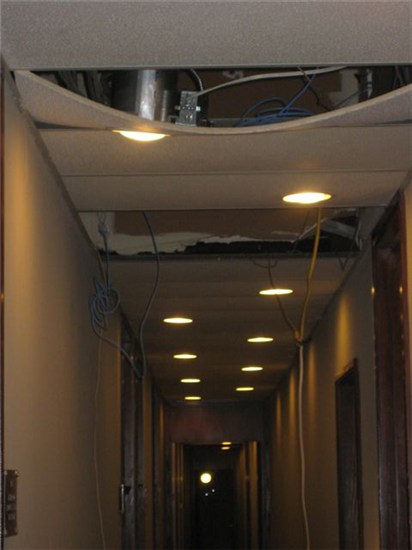
The inside of Dr. Cass’s office during the repair process following one of the two hurricanes to hit his office between 2005 and 2008. Dr. Cass says that as soon as his phone service was restored, patients were calling for appointments.
Assess Whether Insurance is Adequate
We had a business insurance policy that included “windstorm damage” and business loss damage. The insurance rates were reasonable and covered more than 80 percent of the repairs. It took time to get an adjustor to come to the office because so many homeowners and business owners were affected by the storm. It was also a frustrating and long process to prove loss-of-business income, but ultimately, the insurance company paid a loss-of-business claim (which was much less than the actual loss).
We learned a lot about the insurance process, and realized that, fortunately, we had the coverage we needed. We did not make any changes to our policy, and our rates only increased slightly after the first hurricane. However, after the second hurricane, our “windstorm” policy rates increased dramatically as did our deductible.
I wouldn’t want to go through it again, but the experience gained was valuable and will help us overcome any challenges we face in the future.
Related ROB Articles
Electronic Data Loss: Have a Response Plan Before It Happens
Expect the Unexpected: Effectively Manage Crisis
Make a Great First Impression with a Well-Maintained Office Space
Peter J. Cass, OD, is the owner of Beaumont Family Eye Care in Beaumont, Texas. To contact: pcassod@gmail.com

